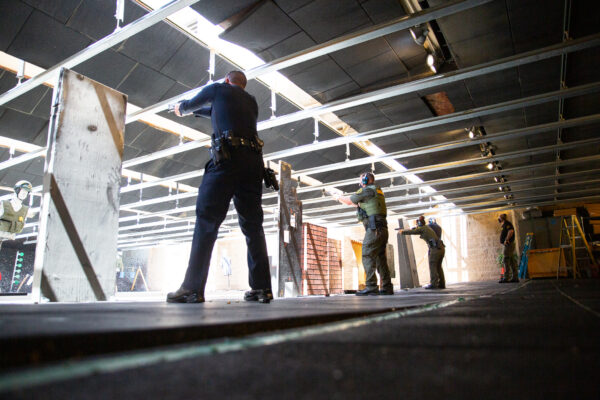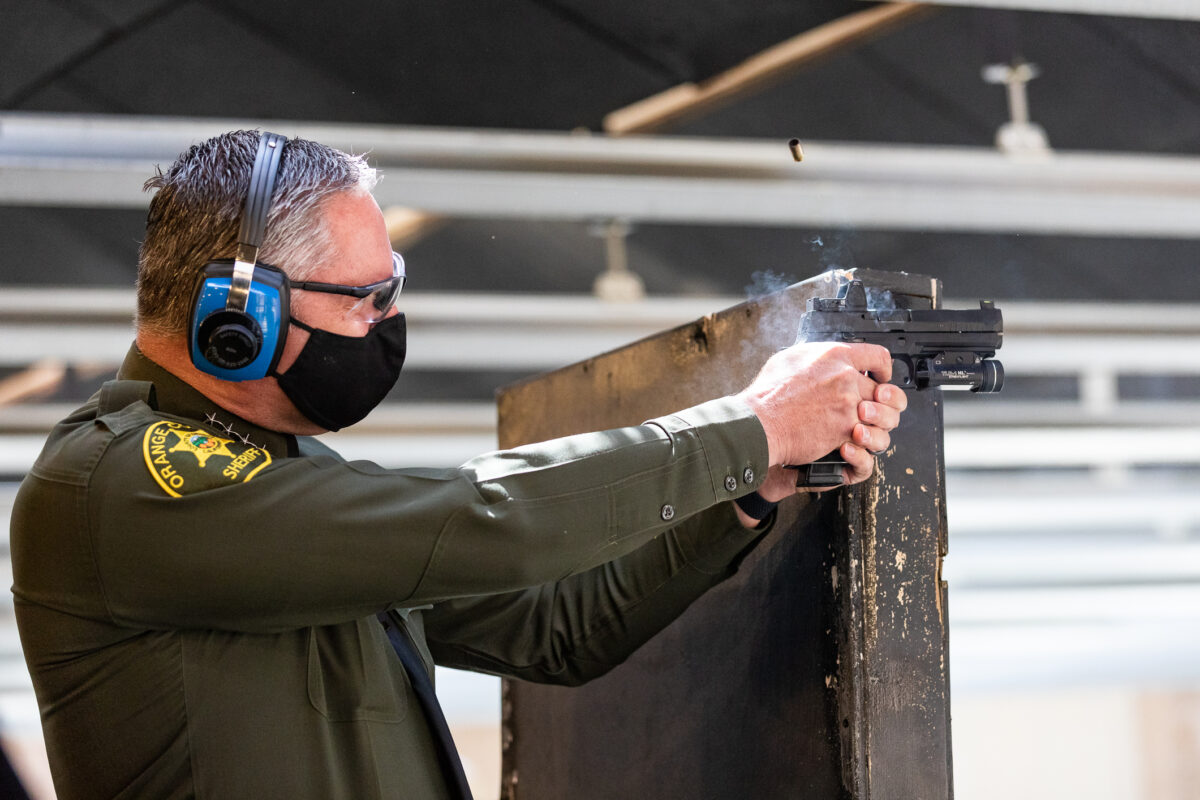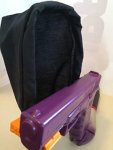jward
passin' thru
California Aims New Gun Bill at ‘Microstamping’ Bullet Casings
By Brad Jones
April 17, 2021 Updated: April 17, 2021
California lawmakers have jumped the gun with legislation targeting firearms manufacturers, handgun owners, and police by requiring pistols to be equipped with technology that would microstamp bullet casings, gun rights groups say.
Assembly Bill 876 (AB 876) would mandate that all new pistols purchased for use by law enforcement officers be equipped with the technology that imprints individualized marks on pistols and bullet casings, allowing investigators to match discharged casings with specific weapons.
The National Rifle Association (NRA) and the National Sports Shooting Foundation (NSSF) oppose the legislation, saying the technology is unreliable and impractical.
“The problem is it doesn’t work,” NSSF spokesman Mark Oliva told The Epoch Times. “It’s unworkable technology, and the mandate to have this requirement has actually turned into a slow-rolling gun ban in California.”
The technology has long been a top priority for gun violence prevention advocates, according to the lawmakers who introduced the new bill. They say it will help law enforcement solve crimes, and create a significant market for new guns with microstamping features.
“For too long, gun manufacturers have prioritized ideology over safety and fought commonsense efforts to incorporate microstamping technology into new firearms,” said Assemblymember Jesse Gabriel (D-Woodland Hills) in a recent press release.
“Our legislation will allow California to use its market power to overcome this obstinance and dramatically expand the use of this important technology.”
Microstamping is a proprietary method of ballistics identification that engraves microscopic markings onto the tip of a gun’s firing pin with a laser. When the gun is fired, an imprint of an alpha-numeric code is transferred from the firing pin to the primer and the cartridge case, leaving a unique identifier that would make it easier for experts to trace bullet casings at crime scenes back to the last registered handgun owner.
The Case for Microstamping
Proponents say the latest legislation builds on California’s landmark Unsafe Handgun Act, first enacted in 1999 and then updated in 2007, that developed safety measures for handguns and required all new semi-automatic pistols sold in the state to be equipped with microstamping technology, once patent restrictions were cleared up.
They have been, and following some refinements to the policy signed into law by Gov. Gavin Newsom last September—including reducing the number of required microstamps on a pistol from two to one—the mandate is set to go into full effect on July 1, 2022.
Law enforcement officers who purchase handguns for use on the job are currently exempt from the requirement. AB 876 would make California the first state in the nation to mandate firearms used by law enforcement to include the technology. Other than revolvers, the bill would require all handguns purchased after July 1, 2023, and used by law enforcement officers while on duty to be microstamped within 90 days of purchase.
“In so doing, we’ll create new markets for microstamped guns, help law enforcement solve violent crimes, ensure our police are equipped with better and safer firearms, and bring more accountability and transparency to situations where there has been an officer-involved shooting,” Gabriel said in a March 23 release.
To avoid the current mandate, firearms manufacturers have not introduced any new handgun models into the state since 2007, according to the release.
“Microstamping technology is reliable, feasible, inexpensive, and valuable to criminal investigations, especially as the rate of unsolved firearm assaults and homicides has increased over the past 40 years,” the announcement stated.
Kris Brown, president of the Brady Center to Prevent Gun Violence, said in the release that the bill will help ensure trust and accountability between law enforcement and the communities they serve.
“Californians continue to demand solutions to not only prevent gun violence but to ensure that the state has every resource available when working to heal communities where violence has occurred,” said Brown.
Earlier this year, the bill’s co-author, Assemblymember David Chiu (D-San Francisco), also introduced Assembly Bill 1478 (AB 1478), which calls for microstamps to be imprinted on two or more places on the interior of a pistol until the new law goes into effect. Chiu called microstamping “a commonsense, crime-solving tool.”
 Police officers fire weapons downrange at the Orange County Sheriff’s Department shooting range in Orange, Calif., on March 30, 2021. (John Fredricks/The Epoch Times)
Police officers fire weapons downrange at the Orange County Sheriff’s Department shooting range in Orange, Calif., on March 30, 2021. (John Fredricks/The Epoch Times)
Unworkable Technology
Oliva said the proposed legislation would be costly for police and law-abiding gun owners, adding that the state is “trying to basically make it impossible for you to buy a handgun.” He said the technology itself is impractical.
“You have to have roughly 10 brass casings collected from a gun to put together one complete eligible code,” Oliva said. Because most criminals fire less than four rounds at a crime scene, there would not be enough shells left behind to make an accurate determination of the markings, he added.
The way the firing pin will strike the round will inevitably leave illegible marks, he said. And every time the firing pin strikes the primer, the mechanism that stamps the code onto the bullet shell will wear down. “So, it becomes further illegible the more you use it,” he said.
Double stamping the casings presents another obstacle. “The problem with marking the brass on the side is you can only do that with laser technology, and then you take the chance of burning through the brass and igniting the cartridge—so that’s completely unworkable,” Oliva said.
On top of that, the technology can be removed from a gun’s firing pin with sandpaper, he said. “Literally, it took a piece of sandpaper scratching across the firing pin and that alpha-numeric code was gone.”
Criminals already “obliterate serial numbers that are etched into the side of a gun,” he added. “What makes them think that they wouldn’t do this to a firing pin?”
Oliva said the technology wouldn’t stop the criminal misuse of firearms—but would put “onerous restrictions on manufacturers that are technologically impossible to meet.”
Trent Butler, volunteer executive director of Orange County Gun Owners, told The Epoch Times that the proposed legislation is “just another attempt by the California Legislature to penalize law-abiding gun owners.”
Even if the technology worked as its proponents claim, it won’t stop criminals from making their own untraceable guns, he said.
“Gang members have been caught with illegal manufacturing operations, where they’re making gun barrels, making gun receivers—everything [from] start to finish,” he said. “Let’s face it, you can’t restrict that knowledge. … It’s just not realistic.”
Butler, a shooting instructor, said that a gun owner who fires 200 rounds a month would wear out a microstamping feature on a firing pin in just over a year.
Dan Reid, the NRA’s Western regional director, told The Epoch Times “it is ill-advised to mandate” the use of the technology.
“Microstamping is not reliable and that is the reason the NRA opposes this proposed law,” Reid said via email.
Law Enforcement
Microstamping was to be required by law in 2010, but conditions in the legislation that stipulated the technology must be unencumbered by patent restrictions meant the law had to be temporarily shelved. In 2013, Vice President Kamala Harris, then California’s Attorney General, declared the technology had cleared patenting hurdles and would be required on all new semi-automatic handguns sold in the state, effective immediately.
According to the NSSF, the requirement “essentially creates a very short list of state-approved firearms that citizens can purchase, thereby preventing Americans from exercising what little Second Amendment rights remain in California.”
Oliva said that when Harris certified the technology, the state created an “unsafe handgun roster.”
“There is a list of guns that are allowed to be purchased in California. Anything that’s not on that roster is not allowed to be purchased,” Oliva said. “People in California need to stand up and tell their elected officials that they work for the citizens and not their special interest groups.”
Last week, the California State Sheriffs’ Association (CSSA) and the California Police Chiefs Association (CPCA) told The Epoch Times via email that they are aware of the newly proposed state legislation, but haven’t yet taken an official position on the bills.
Said Oliva, “No law enforcement department has asked for this, and no law enforcement department wants this.”
On April 14, AB 876 was re-referred to the Assembly Appropriations Committee for further review.
Posted for fair use

 www.theepochtimes.com
www.theepochtimes.com
By Brad Jones
April 17, 2021 Updated: April 17, 2021
California lawmakers have jumped the gun with legislation targeting firearms manufacturers, handgun owners, and police by requiring pistols to be equipped with technology that would microstamp bullet casings, gun rights groups say.
Assembly Bill 876 (AB 876) would mandate that all new pistols purchased for use by law enforcement officers be equipped with the technology that imprints individualized marks on pistols and bullet casings, allowing investigators to match discharged casings with specific weapons.
The National Rifle Association (NRA) and the National Sports Shooting Foundation (NSSF) oppose the legislation, saying the technology is unreliable and impractical.
“The problem is it doesn’t work,” NSSF spokesman Mark Oliva told The Epoch Times. “It’s unworkable technology, and the mandate to have this requirement has actually turned into a slow-rolling gun ban in California.”
The technology has long been a top priority for gun violence prevention advocates, according to the lawmakers who introduced the new bill. They say it will help law enforcement solve crimes, and create a significant market for new guns with microstamping features.
“For too long, gun manufacturers have prioritized ideology over safety and fought commonsense efforts to incorporate microstamping technology into new firearms,” said Assemblymember Jesse Gabriel (D-Woodland Hills) in a recent press release.
“Our legislation will allow California to use its market power to overcome this obstinance and dramatically expand the use of this important technology.”
Microstamping is a proprietary method of ballistics identification that engraves microscopic markings onto the tip of a gun’s firing pin with a laser. When the gun is fired, an imprint of an alpha-numeric code is transferred from the firing pin to the primer and the cartridge case, leaving a unique identifier that would make it easier for experts to trace bullet casings at crime scenes back to the last registered handgun owner.
The Case for Microstamping
Proponents say the latest legislation builds on California’s landmark Unsafe Handgun Act, first enacted in 1999 and then updated in 2007, that developed safety measures for handguns and required all new semi-automatic pistols sold in the state to be equipped with microstamping technology, once patent restrictions were cleared up.
They have been, and following some refinements to the policy signed into law by Gov. Gavin Newsom last September—including reducing the number of required microstamps on a pistol from two to one—the mandate is set to go into full effect on July 1, 2022.
Law enforcement officers who purchase handguns for use on the job are currently exempt from the requirement. AB 876 would make California the first state in the nation to mandate firearms used by law enforcement to include the technology. Other than revolvers, the bill would require all handguns purchased after July 1, 2023, and used by law enforcement officers while on duty to be microstamped within 90 days of purchase.
“In so doing, we’ll create new markets for microstamped guns, help law enforcement solve violent crimes, ensure our police are equipped with better and safer firearms, and bring more accountability and transparency to situations where there has been an officer-involved shooting,” Gabriel said in a March 23 release.
To avoid the current mandate, firearms manufacturers have not introduced any new handgun models into the state since 2007, according to the release.
“Microstamping technology is reliable, feasible, inexpensive, and valuable to criminal investigations, especially as the rate of unsolved firearm assaults and homicides has increased over the past 40 years,” the announcement stated.
Kris Brown, president of the Brady Center to Prevent Gun Violence, said in the release that the bill will help ensure trust and accountability between law enforcement and the communities they serve.
“Californians continue to demand solutions to not only prevent gun violence but to ensure that the state has every resource available when working to heal communities where violence has occurred,” said Brown.
Earlier this year, the bill’s co-author, Assemblymember David Chiu (D-San Francisco), also introduced Assembly Bill 1478 (AB 1478), which calls for microstamps to be imprinted on two or more places on the interior of a pistol until the new law goes into effect. Chiu called microstamping “a commonsense, crime-solving tool.”
 Police officers fire weapons downrange at the Orange County Sheriff’s Department shooting range in Orange, Calif., on March 30, 2021. (John Fredricks/The Epoch Times)
Police officers fire weapons downrange at the Orange County Sheriff’s Department shooting range in Orange, Calif., on March 30, 2021. (John Fredricks/The Epoch Times)Unworkable Technology
Oliva said the proposed legislation would be costly for police and law-abiding gun owners, adding that the state is “trying to basically make it impossible for you to buy a handgun.” He said the technology itself is impractical.
“You have to have roughly 10 brass casings collected from a gun to put together one complete eligible code,” Oliva said. Because most criminals fire less than four rounds at a crime scene, there would not be enough shells left behind to make an accurate determination of the markings, he added.
The way the firing pin will strike the round will inevitably leave illegible marks, he said. And every time the firing pin strikes the primer, the mechanism that stamps the code onto the bullet shell will wear down. “So, it becomes further illegible the more you use it,” he said.
Double stamping the casings presents another obstacle. “The problem with marking the brass on the side is you can only do that with laser technology, and then you take the chance of burning through the brass and igniting the cartridge—so that’s completely unworkable,” Oliva said.
On top of that, the technology can be removed from a gun’s firing pin with sandpaper, he said. “Literally, it took a piece of sandpaper scratching across the firing pin and that alpha-numeric code was gone.”
Criminals already “obliterate serial numbers that are etched into the side of a gun,” he added. “What makes them think that they wouldn’t do this to a firing pin?”
Oliva said the technology wouldn’t stop the criminal misuse of firearms—but would put “onerous restrictions on manufacturers that are technologically impossible to meet.”
Trent Butler, volunteer executive director of Orange County Gun Owners, told The Epoch Times that the proposed legislation is “just another attempt by the California Legislature to penalize law-abiding gun owners.”
Even if the technology worked as its proponents claim, it won’t stop criminals from making their own untraceable guns, he said.
“Gang members have been caught with illegal manufacturing operations, where they’re making gun barrels, making gun receivers—everything [from] start to finish,” he said. “Let’s face it, you can’t restrict that knowledge. … It’s just not realistic.”
Butler, a shooting instructor, said that a gun owner who fires 200 rounds a month would wear out a microstamping feature on a firing pin in just over a year.
Dan Reid, the NRA’s Western regional director, told The Epoch Times “it is ill-advised to mandate” the use of the technology.
“Microstamping is not reliable and that is the reason the NRA opposes this proposed law,” Reid said via email.
Law Enforcement
Microstamping was to be required by law in 2010, but conditions in the legislation that stipulated the technology must be unencumbered by patent restrictions meant the law had to be temporarily shelved. In 2013, Vice President Kamala Harris, then California’s Attorney General, declared the technology had cleared patenting hurdles and would be required on all new semi-automatic handguns sold in the state, effective immediately.
According to the NSSF, the requirement “essentially creates a very short list of state-approved firearms that citizens can purchase, thereby preventing Americans from exercising what little Second Amendment rights remain in California.”
Oliva said that when Harris certified the technology, the state created an “unsafe handgun roster.”
“There is a list of guns that are allowed to be purchased in California. Anything that’s not on that roster is not allowed to be purchased,” Oliva said. “People in California need to stand up and tell their elected officials that they work for the citizens and not their special interest groups.”
Last week, the California State Sheriffs’ Association (CSSA) and the California Police Chiefs Association (CPCA) told The Epoch Times via email that they are aware of the newly proposed state legislation, but haven’t yet taken an official position on the bills.
Said Oliva, “No law enforcement department has asked for this, and no law enforcement department wants this.”
On April 14, AB 876 was re-referred to the Assembly Appropriations Committee for further review.
Posted for fair use

California Proposal Seeks to Boost 'Microstamping' of Bullet Casings
A proposal introduced by California lawmakers that would require all pistols purchased by law enforcement officers to be ...

